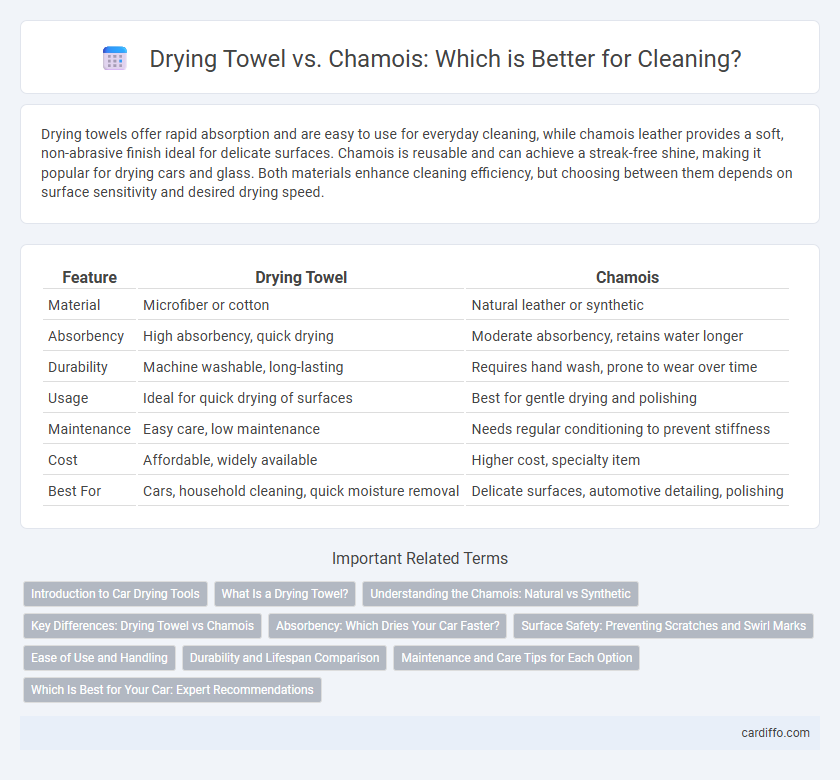Drying towels offer rapid absorption and are easy to use for everyday cleaning, while chamois leather provides a soft, non-abrasive finish ideal for delicate surfaces. Chamois is reusable and can achieve a streak-free shine, making it popular for drying cars and glass. Both materials enhance cleaning efficiency, but choosing between them depends on surface sensitivity and desired drying speed.
Table of Comparison
| Feature | Drying Towel | Chamois |
|---|---|---|
| Material | Microfiber or cotton | Natural leather or synthetic |
| Absorbency | High absorbency, quick drying | Moderate absorbency, retains water longer |
| Durability | Machine washable, long-lasting | Requires hand wash, prone to wear over time |
| Usage | Ideal for quick drying of surfaces | Best for gentle drying and polishing |
| Maintenance | Easy care, low maintenance | Needs regular conditioning to prevent stiffness |
| Cost | Affordable, widely available | Higher cost, specialty item |
| Best For | Cars, household cleaning, quick moisture removal | Delicate surfaces, automotive detailing, polishing |
Introduction to Car Drying Tools
Car drying tools include drying towels and chamois, each designed to efficiently remove water and reduce streaks after washing. Microfiber drying towels offer high absorbency and softness that prevents scratches, while natural chamois leather provides excellent water absorption and durability for smooth, lint-free finishes. Choosing the right tool depends on the vehicle's surface sensitivity and drying preferences for achieving optimal results.
What Is a Drying Towel?
A drying towel is a highly absorbent microfiber cloth designed to quickly and effectively remove water from surfaces without leaving streaks or lint. It outperforms traditional drying materials by soaking up large amounts of moisture, making it ideal for drying cars, glass, and delicate finishes. Unlike a chamois, which is made from natural leather, drying towels are synthetic, reusable, and easier to maintain.
Understanding the Chamois: Natural vs Synthetic
Chamois towels come in two main types: natural leather chamois made from sheepskin and synthetic versions crafted from microfiber materials. Natural chamois offers superior absorption and a soft, lint-free finish, making it ideal for delicate surfaces, while synthetic chamois dries faster and is more durable for heavy-duty cleaning tasks. Choosing between natural and synthetic chamois depends on the surface sensitivity and drying speed required during cleaning.
Key Differences: Drying Towel vs Chamois
Drying towels, often made from microfiber, offer superior absorbency and faster drying times compared to traditional chamois, which are crafted from natural or synthetic leather. Chamois provide a gentle, streak-free finish ideal for delicate surfaces but require more maintenance to prevent odor and deterioration. While drying towels are reusable and machine washable, chamois typically need careful hand washing and air drying for longevity.
Absorbency: Which Dries Your Car Faster?
Chamois cloths exhibit superior absorbency compared to traditional drying towels, enabling faster water removal from car surfaces and reducing drying time. Their unique leather-like texture efficiently captures and retains moisture, preventing streaks and water spots. High-quality drying towels, often made from microfiber, also offer excellent absorbency but may require multiple passes to achieve the same drying speed as a chamois.
Surface Safety: Preventing Scratches and Swirl Marks
Using a chamois for drying automotive surfaces helps prevent scratches and swirl marks due to its soft, non-abrasive texture that gently lifts water without rubbing contaminants into the paint. Drying towels, especially microfiber variants, offer excellent absorption but require frequent cleaning to avoid trapping dirt particles that can cause micro-scratches. Choosing high-quality, properly maintained drying tools is essential for preserving the surface integrity and achieving a scratch-free finish.
Ease of Use and Handling
Drying towels offer superior ease of use with their large surface area and plush fibers that quickly absorb moisture without much effort, making them ideal for everyday cleaning tasks. Chamois, though highly absorbent, require careful wringing and maintenance to prevent damage, which can complicate handling compared to drying towels. The soft texture of chamois provides gentle cleaning for delicate surfaces but demands more skill and care during use.
Durability and Lifespan Comparison
Drying towels typically offer enhanced durability due to their dense microfiber weave, which withstands frequent washing and maintains softness over time, extending their lifespan beyond 300 uses. Chamois leather, although highly absorbent and gentle on surfaces, tends to degrade faster with regular exposure to water and improper drying, often lasting only around 50 to 70 uses before losing effectiveness. Choosing a drying towel over a chamois can result in a longer-lasting cleaning tool that balances absorbency with structural integrity, making it ideal for heavy-duty or repeated drying tasks.
Maintenance and Care Tips for Each Option
Drying towels require frequent washing to prevent bacteria buildup and maintain absorbency, ideally using gentle detergents and avoiding fabric softeners. Chamois leather should be rinsed after each use and air-dried away from direct sunlight to preserve its softness and durability. Proper maintenance ensures both drying towels and chamois provide effective cleaning performance and long-term usability.
Which Is Best for Your Car: Expert Recommendations
Drying towels and chamois each offer distinct advantages for car care: microfiber drying towels provide superior absorbency and a gentle touch that reduces the risk of scratches, making them ideal for daily use, while natural or synthetic chamois excel at quickly soaking up water, especially on larger surfaces. Experts recommend microfiber towels for enhanced durability and ease of cleaning, whereas chamois remain favored for their softness and classic drying technique. Choosing the best option depends on your car's paint sensitivity and your preferred drying efficiency.
Drying towel vs Chamois Infographic

 cardiffo.com
cardiffo.com